

Mana
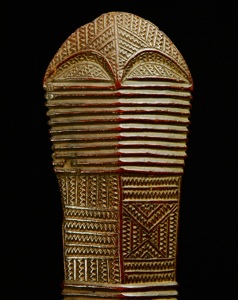
It is not the intent of this forum to define the concept of mana. We consider that Its concepts and philosophies are insufficiently known to Western convention and thus we have no (or very little) empathy of it. Therefor, we will bring to you the explanations and teachings of others as they have been previously published.
See: http://en.wikipedia.org/wiki/Mana
Steven Hooper, Pacific Encounters; Art & Divinity in Polynesia 1760 - 1860, The British Museum Press, 2006. “if a chief in Polynesia was essentially an embodiment of life-conferring power, what was the nature of this power? Divine power in Polynesia was, and in many places, still is, referred to by the term mana (and in some case by sau or hau). Today there is no single definition of mana. It is a term which has undergone shifts in meaning in changing political and religious circumstances. In its widest sense, mana means efficacy of divine origin, an ability to effect which go beyond normal human agency. It is not so much a mystical abstract power which people possess , but rather an efficacy manifested in specific outcomes such as fertility, health or success. It is a means by which divinity manifests its presence in the world through particular persons and things. Being of divine origin, mana is a problematic pote It ncy, dangerous, life - creating and life - destroying and must be managed with care. Because it is closely associated with installed (consecrated) chiefs, they have to be treated appropriately in order that mana can be directed to beneficial ends. Mana is fundamental to chiefship and authority, so much so that Shore claims in his perceptive review of the topic, that ‘without an understanding of mana and its related concepts, there is no path into Polynesian worldview’
T. Barrow, Art and Life in Polynesia, A. H. & A. W. Reed Ltd., Pall Mall Press, London, 1971, a most succinct definition; “Mana was a subtle power that could be possessed by people and things: its presence was awarded with prestige within the community in proportion to the amount possessed. “People acquired mana through inheritance and accumulated successes, while objects acquired it through effectiveness.”
Phyllis Herda, Gender, rank and power in 18th century Tonga, Journal of Pacific History, V. xxii, # 3, July - #4 October, 1987, p. 196, “Mana, a complex cultural construction involving access to or bestowal of supernatural power, was intricately bound up with the reputation of political figures (chiefs) in historic Tonga.”
Allen Wardwell, Island Ancestors, Detroit Institute of Arts Founders Society, 1994. “in Polynesia, mana was regarded as a supernatural force that had an influence on all the achievements and abilities of humans. It was everywhere, but its distribution in nature, objects and mankind was not consistent. Mana could be acquired through inheritance, but ordinary people could gain it and increase their possession of it through ritual performances and careful attention to patterns of behavior and pursuits thought to be particularly beneficial. It might be easily lost through carelessness, ignorance, or out of neglect to follow any number of meticulously prescribed actions. Bad fortune could also deprive a person of mana. An individual who was taken captive or killed lost all of his accumulated mana to his adversary. The more mana an individual had, the more powerful he was and many deities were regarded as different form mortals only because they possessed greater amounts of it.
Mana was recognized in an individual by his position, skills, reputation and influence. A person might show its presence through acts of courage, great skill in such activities as carving, dancing or entertaining and the ownership of things that had their own mana. Among the latter, mana was measured by degrees of effectiveness. An adze that was particularly well balanced, was fitted with an especially hard an sharp blade and had been previously owned by a master carver had more mana than an average tool with no history.”
Published anecdotes describing mana:
from Gifford, “The word mana, in Tongan, means ‘miracle, thunder; to bewitch, to cause something to happen to another.’ In a most interesting explanation directly from a Tongan informant, Gifford goes on, “Weapons were placed in a temple in order to acquire the mana of the god. John Havea said that when a weapon has mana, it is the ‘abode of the spirit (faahikehe’) and it confers prowess and might on the user. A mana charged club loaned to another would take its virtue with it.”
Then, page 327, Gifford provides us this astounding anecdote; “ Vahai’s club was so full of mana that is could not lie still and was always moving, (futefute) as it reposed in the house. On one occasion a man was sent to fetch from the house, Vahai’s club, which was wrapped in a mat. Entering he could see no club, but only a bundle of mat, which kept moving and he thought it to be a child. Returning he said there was no club, only this child. Vahai told him to go and bring it, which he did, it being the mana club. Vahai’s club gave warning of war planned against Vahai, by moving. The moving was caused by the ‘mana of the god’”.
Further considerations of mana and how it’s apparent presence is considered by Western collectors of Oceanic Art
It is within the reasonable purview of this website, to assist those previously unaware of the concept of mana, of its use by contemporary collectors and dealers of Polynesian material culture, in describing certain particular examples of Polynesian material culture. I do this without any reference or implication to past or present cultural meanings of mana to Polynesia or Polynesians.
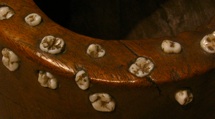
Further physical manifestations of mana could imply the transmitting of mana from the owner to the club, in a contagious sort of manner, or the other way around. For example, certain Fijian clubs might have hash marks carved into it, indicating successful battles. Each success provides for additional infusions of mana, to the warrior and the club, the hash marks a physical indicator of this.
Accordingly, in the view of the market, the object presenting the appearance of having mana, is considered a piece of greater merit, giving it a higher market value in contemporary market terms, than an object with a “newer, fresher” appearance. No experience, no success or effectiveness, no chiefly ownership = probably, no mana. Theoretically, two identically carved objects, of the same size, wood type, and design, both caved of the same skill level, perhaps even the same hand but for one having greater wear and use, with a deeper patina, will in most cases have more market value . At times, the patina and wear, in and of itself, on any piece, can add to higher levels aesthetics and appreciation, both visually and ‘ to the touch”. This assumes the level of wear, perhaps in the case of a club, to include “battle damage” that does not interfere with its aesthetics.
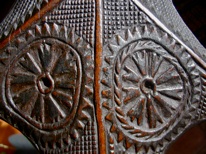
One may encounter phrases as “dripping mana”, “oozing mana”, “Imbued with great mana”, “possessing great mana”, etc., used to describe such artifacts. It has been my experience, that the older, well worn, yet aesthetically intact objects are of great preference and provide the observer with a myriad of hypothetical historical scenarios to contemplate.
credit: James Barzyk
In the below images, please note the extreme wear at the point where this ula made contact with the girdle of the warrior. This example also illustrates a deep patina from constant, inadvertent friction, handling, and oiling. All of these are physical indicators of mana. It took generations to get this very hard wood to this point and it is the experience (mana) of this ula that inspired its continued use to this extent. The incised dots and hash marks along the shaft also indicate this ula was witness or participant in a number of noteworthy events, perhaps battles, feasts, sexual conquests, etc. The mana has been enhanced by its participation in these events and the experiences contained therein stay with it and can be passed to others enhancing their own personal mana.
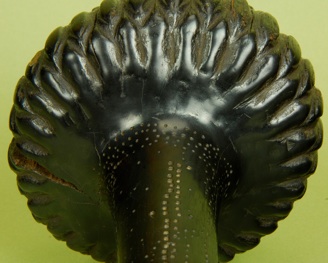
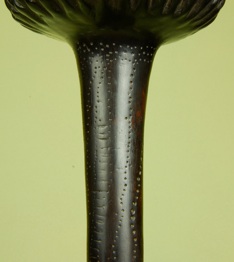
It is considered that an understanding of mana is essential if one is to be able to fully embrace and appreciate the material culture and art forms of Polynesia.